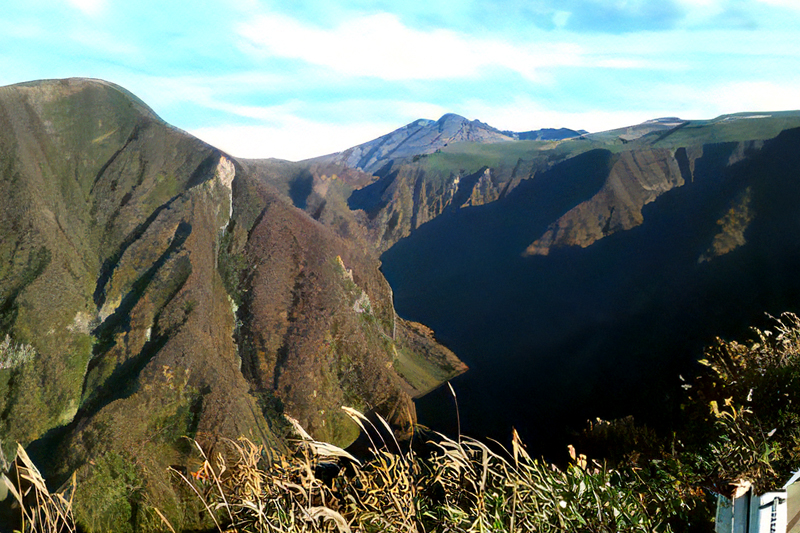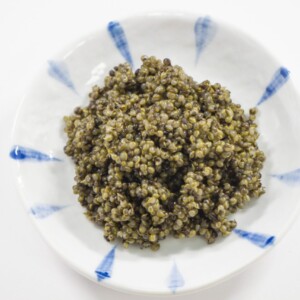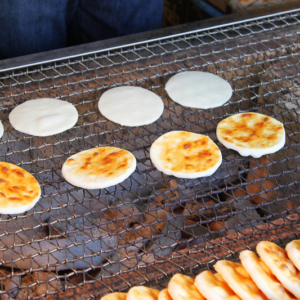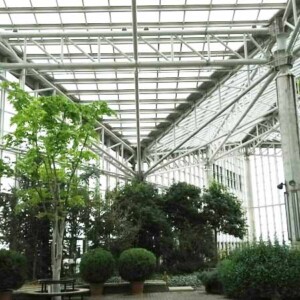
[Chokaisan and Tobishima Geopark: Nikaho Edition (2)] Coexistence with nature brought about by the wisdom of our ancestors
table of contents
- 1 A wetland where large beech and oak trees and rare moss grow. Nakajimadai/Shishigahana Wetland
- 2 ``Naso Valley'' is a 500m vertical wall made of mille-feuille-like lava that has flowed out from numerous eruptions.
- 3 Shirataki Falls in Naso, a famous waterfall where Yamabushi trained, and Kinmine Shrine
- 4 Comfortable mountain highway “Chokai Blue Line”
- 5 ``Nigaho Plateau'' is located at an altitude of 500 meters, where the earth and sand that washed down from the collapse of Mt. Chokai accumulated at the foot of the mountain.
- 6 Japan's largest wind power plant "Shin-Nigaho Kogen Wind Power Plant"
- 7 Kamigo's warm water channels raise cold snowmelt water to a temperature suitable for rice cultivation
- 8 “Yuri Coast Wave Prevention Stone Wall” protected houses and farmland from big waves and winds
- 9 The “Innai Oil Field” once boasted one of the highest production volumes in Japan.
- 10 Articles related to Mt. Chokai and Tobishima Geopark
In the first part of Mt. Chokai and Tobishima Geopark , we introduced geosites on the Sea of Japan, such as " Kujukushima (Zogata) " and " Misaki Coast ," but in the second part, we introduce geosites inland areas and the wisdom of our ancestors to coexist with the global environment.
A wetland where large beech and oak trees and rare moss grow. Nakajimadai/Shishigahana Wetland

Nakajimadai is a forest and marsh region located at the foot of Mt. Chokai, about 450m to 830m, and is designated as Chokai Natural Rest Forest
It is approximately 942 hectares (about 200 Tokyo Domes), and the rich nature of Mt. Chokai is spreading out, including giant beech and oak trees, and Shishigahana Boil, which is
Nakajimadai/Shishigahana Wetland has a walking course with a wooden path that is approximately 5km in length. Along the walking course, giant beech trees called Agariko creating a mysterious landscape along with Agariko Daio which has been selected as one of the Giants of the Forest I am.

Shishigahana Boil is located at an altitude of 550m, and is recharged with abundant spring water and is grown with a variety of aquatic wet plants.
Among them, handel-solid moss and lily-sea moss are rare moss worldwide, and the moss that are mixed with these moss and grown into a ball are commonly known as "Toriumi Marimo."
In addition, the marsh can also be seen in the spring area called " Detsubo " and the end cliffs of lava flows on Mt. Chokai, and are designated as national natural monuments.
Nakajimadai/Shishigahana Marsh <Information>
- Facility name: Nakajimadai/Shishigahana Wetland
- Location: Nakashimatai National Forest, Yokooka, Nakajima-tai, Nikaho City, Akita Prefecture
- Phone number: 0184-43-6608 (Nikaho City Tourism Association)
- access:
- Public transportation: Approximately 20 minutes by car or walk from JR Uetsu Main Line Kurogata Station
- Car: Approximately 15 minutes from Nihonkai-Tohoku Expressway Zogata IC
Google Map
``Naso Valley'' is a 500m vertical wall made of mille-feuille-like lava that has flowed out from numerous eruptions.

Naso Valley is a valley located near the 6th station of Mt. Chokai, and is approximately 300m to 500m deep. The river over the years shaved the lava layers, creating a V-shaped valley.
The steep cliffs are visible as they are mille-feuille, with lava from Mt. Chokai, which has been erupting since around 600,000 years ago. The lava at the bottom of the valley is 400,000 to 450,000 years old, and the top is said to be around 100,000 years old.
Just looking up at Naso Valley from below is impressive, but the Hokotate Observation Deck, located at the fifth station of Mt. Chokai, offers a view of Naso Valley from above.
The valley, which can be seen below the Hokotate Observation Deck, is 337m deep, and completely fits Tokyo Tower (333m). You can climb the Hokotate Observatory on the "Chokai Blue Line (closed in winter from early November to late April)" that runs along the middle of Mt. Chokai. From the Hokotate Observation Deck, you can see Tobishima and the Oga Peninsula below you, making it a spectacular sight that competes in the Nikaho area 1.2.
Naso Valley <Information>
- Facility name: Naso Valley (Hokodate Observation Deck)
- Location: Kotaki (Hokodate), Zogata-cho, Nikaho City, Akita Prefecture
- Phone number: 090-2021-0270 (Hokodate Visitor Center)
- access:
- Public transportation: Approximately 35 minutes by reservation-only shared mountain climbing bus, Chokai Blue Liner, or approximately 30 minutes by car from JR Uetsu Main Line Zogata Station.
- *Chokai Blue Liner operates on Saturdays, Sundays, and holidays from June to early October.
- *Mountain highway “Chokai Blue Line” is closed in winter from early November to late April.
- *Chokai Blue Liner operates on Saturdays, Sundays, and holidays from June to early October.
- Public transportation: Approximately 35 minutes by reservation-only shared mountain climbing bus, Chokai Blue Liner, or approximately 30 minutes by car from JR Uetsu Main Line Zogata Station.
- Car: Approximately 15 minutes from Nihonkai-Tohoku Expressway Zogata IC
Google Map
Shirataki Falls in Naso, a famous waterfall where Yamabushi trained, and Kinmine Shrine

Naso Shirataki is a famous waterfall located near the starting point on the Akita prefecture side of the Toriumi Blue Line.
Kinpo Jinja Shrine, which was the base of Shugenja (yamabushi), which is the place of training on Mt. Chokai, and up and down the long stairs, you will find a waterfall. It is 26m tall and 11m wide, and is designated as a national scenic spot. You can also go down to the waterfall basin, as well as enjoy the waterfall at various angles, including observation decks, grounds, and suspension bridges.
Shirataki in Naso/Kanmine Shrine <Information>
- Facility name: Naso Shirataki/Kinmine Shrine
- Location: Kotaki, Nasozawadaihido, Zogata-cho, Nikaho City, Akita Prefecture
- Phone number: 0184-43-6608 (Nikaho City Tourism Association)
- access:
- Public transportation: Approximately 15 minutes by car or walk from JR Uetsu Main Line Zogata Station
- Car: Approximately 6 minutes from Nihonkai-Tohoku Expressway Zogata IC
Google Map
Comfortable mountain highway “Chokai Blue Line”

is a mountain tourist road that is approximately 34.9km from Shirataki in Naso in Zogatacho, Nikaho Fukiura ) in Yuzamachi,
Fukiura, Yusa-cho, home to the tourist attraction " Julokurakaniwa Hokotate (Naso-Keiku Hokotate Observatory). The difference in elevation is over 1,000m, and the Akita Prefecture side runs through the grasslands, and the Yamagata Prefecture side runs through the beech forests.
From the Akita Prefecture side, the Sea of Japan spreads out on the sea side, and the majestic landscape of Naso Valley approaches on the opposite mountain side.
The Chokai Blue Line is closed from early November to late April due to heavy snowfall. There is no toll toll, but it is a famous place for bicycle touring, so please be careful when driving.
Toriumi Blue Line <Information>
- Facility name: Chokai Blue Line
- section:
- Akita Prefecture side/Prefectural Route 131 Chokai Park Kotaki Line From Kotaki (prefectural border) to Kotaki (Naso Shirataki) 18.1km
- Yamagata Prefecture side/Prefectural Route 210/Chokai Park Fukiura Line From Fukiura (prefectural border) to Fukiura (Juroku Rakan Rock) 16.8km
- Toll fee: Free
- Passable period: Late April to early November (closed in winter)
- *The passable period varies depending on the weather conditions each year.
- Information on closures, regulations, etc.:
- Akita Prefecture/ Akita road information
- Yamagata Prefecture/ Yamagata Prefecture traffic regulation information
- Japan Road Traffic Information Center/ Japan Road Traffic Information Center
Google Map
``Nigaho Plateau'' is located at an altitude of 500 meters, where the earth and sand that washed down from the collapse of Mt. Chokai accumulated at the foot of the mountain.

Nigaho Plateau is a hilly area at an altitude of about 500m, made from rocks (avalley rocks) that have fallen like an avalanche due to the collapse of Mt. Chokai.
Inside the grasslands are large and small lakes, marshlands, and large-scale wind power plants. From the observation deck at Hibari-so, a base facility on Nigaho Plateau, you can see not only the majestic Mt. Chokai but also the Sea of Japan, and the large 360-degree panoramic view is a must- see .
There are also ranches and campgrounds scattered throughout the area, as well as cycling roads. Tsuchida Farm , milk, yogurt, and cheese made using raw milk from Jersey cows are very popular. Sausages are also popular.
Nigaho Kogen <Information>
- Facility name: Nikaho Kogen
- Location: Nikaho City, Akita Prefecture, Baba Aza Kushigoya, etc.
- access:
- Public transportation: Approximately 20 minutes by car from Nikaho Station on the JR Uetsu Main Line, or by shared taxi (reservation required, minimum of 2 people)
- Car: Approximately 20 minutes from Nihonkai-Tohoku Expressway Nikaho IC
- *Shared taxi
- Phone number: 0184-43-2030 (Shogata Joint Transportation)
- Business period: July 1st to November 30th
- Reservation: Reservation required / Minimum of 2 people
- URL: Nikaho city shared taxi
- Facility name: Hibarisou/Nigaho Kogen Observation Deck
- Location: 4-5 Baba Ajikushigoya, Nikaho City, Akita Prefecture
- Phone number: 0184-43-3230 (Nikaho City Tourism Division)
- Business hours: 9:00-17:00 (campsite reception hours)
- Business period: May to end of November
- Facility name: Tsuchida Farm
- Location: 4-6 Toushiyama Baba, Nikaho City, Akita Prefecture
- Phone number: 0184-36-2348
- business hours:
- March-December/9:00-17:00
- January/February/9:30-17:00
- Regular holidays: Irregular holidays (please inquire in advance)
- URL: Tsuchida Farm
Google Map
Japan's largest wind power plant "Shin-Nigaho Kogen Wind Power Plant"

Nikaho Kogen Wind Power Plant which has been in operation since 2001, the Nikaho Daini Wind Farm, which started commercial operation in 2020 (18 wind turbines/output 41,400kW). The "Nigaho Kogen Wind Power Plant" has been under replacement construction since 2021.
Construction was completed in March 2024 and commercial operation began as a completely new "Shin Nigaho Plateau Wind Farm."
The Shin-Nigaho Plateau Wind Farm was originally five wind turbines (single output of 1,650kW), but has been renewed to six of the largest 4,300kW wind turbines in Japan. The output has not been changed since before the replacement (restrained operation was carried out within the previous output of 24,750kW), and the total power generation at Nigaho Plateau is 66,150kW.
Shin-Nigaho Highland Wind Farm <Information>
- Facility name: Shin-Nikaho Kogen Wind Power Plant
- Location: Nikaho City, Akita Prefecture
- Operating company: J-Wind Co., Ltd. (J-Power Group)
- *J-Power is the communication name of Electric Power Development Co., Ltd.
Google Map
Kamigo's warm water channels raise cold snowmelt water to a temperature suitable for rice cultivation

Kamigo's warm water canals are warm water that farmers who used the cold melting of Mt. Chokai for rice cultivation were conceived to help warm the too-cold water to a temperature suitable for rice cultivation.
The melting of snow on Mt. Chokai is around 10°C even in the summer, which is too cold for rice cultivation and does not grow well. Therefore, a method was devised to warm the snow by exposing it to the sunlight by making it wider, shallower, and more steps. This has led to a rise in water temperatures of 2 to 8°C, and the rice harvest has also increased dramatically.
The heated waterway was built in 1927 (Showa 2), with a length of 648m, and was the first heated waterway in Japan. Since then, many hot waterways have been completed, including Omori Onsen Waterway and Mizuoka Onsen Waterway, with a total length of 6.28km.
`` Kamigo Warm Canals '' is one of the Ministry of Agriculture, Forestry and Fisheries' `` Top 100 Canals '' and a tangible cultural property (building) designated by Akita Prefecture .
Kamigo's warm waterway group <Information>
- Facility name: Kamigo warm water channels
- Location: Yokooka, Kogatacho, Nikaho City, Akita Prefecture, etc.
- Phone number: 0184-43-3230 (Nikaho City Tourism Division)
- access:
- Public transportation: Approximately 5 minutes by taxi from JR Uetsu Main Line Zogata Station
- Car: Approximately 5 minutes from Nihonkai-Tohoku Expressway Zogata IC
Google Map
“Yuri Coast Wave Prevention Stone Wall” protected houses and farmland from big waves and winds

Yuri Coast Wave Stone Wall <Information>
- Facility name: Yuri coast wave stone wall
- Location: Hi, Nikaho City, Akita Prefecture, Serita, Nikaho City
- Phone number: 0184-43-3230 (Nikaho City Tourism Division)
- access:
- Public transportation: (Hi) 4 minutes by taxi from Kanaura Station on the JR Uetsu Main Line, (Serita) approximately 6 minutes by taxi from Nikaho Station on the JR Uetsu Main Line
- Car: (Flight) Approximately 5 minutes from Kanaura IC on the Nihonkai Tohoku Expressway (Serita) Approximately 7 minutes from Nikaho IC on the Nihonkai Tohoku Expressway
Google Map
The “Innai Oil Field” once boasted one of the highest production volumes in Japan.

The Innai Oil Field (Innai, Nikaho City) was once one of the largest oil fields in Japan, and its former site was selected by the Economy, Trade and Industry Award as part of the Modern Industrial Heritage Group 33, ``Japan's modern oil industry that began in the Kanto-Koshinetsu region, including Niigata.'' It has been preserved as a "modernization industrial heritage site that tells the story of the history of the world."
Japan's oil industry began with mining in Echigo (Niigata Prefecture) in the late 16th century. It began in earnest in the early Meiji period, when engineers were invited from the United States to investigate oil reserves mainly in Koshinetsu and northern Japan.
The first oil produced after the Meiji era was Sagara Town in Shizuoka Prefecture (Sagara, Makinohara City) in 1873. Later, oil fields with large reserves were discovered on the Sea of Japan side of Niigata Prefecture, and Japan's oil industry boomed.
At the end of the Meiji era, the wave of oil development reached not only Niigata Prefecture but also Akita Prefecture. An oil field discovered in Akita City in 1914 (Taisho 3) produced a large amount of crude oil gushing out. Many oil companies took notice of this, and an oil development boom began in Akita Prefecture.
It seems that it was discovered in the late Meiji period that there was an oil field within Nikaho City, but trial drilling began in earnest in 1922 (Taisho 11), and oil was successfully extracted the following year in 1923. In 1932 (Showa 7), Asahi Oil (the predecessor company of Showa Sekiyu [Gendemitsu Kosan]) succeeded in extracting 8 kiloliters of oil per day.
The in-house oil field reached its peak in 1935 (Showa 10), with a total annual production of 110,000 kiloliters, making it one of the largest oil fields in Japan. After that, oil production gradually decreased due to resource depletion and decline in international competitiveness, and the mine was closed in 1995.
Modernization Industrial Heritage Group 33 ``Modernization Industrial Heritage Sites that tell the history of Japan's modern oil industry that began in the Kanto-Koshinetsu region such as Niigata'' includes the ``Internal Oil Field Related Heritage'' and the `` Toyokawa Oil Related Heritage '' (Katagami, Akita Prefecture). City), `` Kanazu Oil Field Related Heritage (Oil no Sato Park)'' ( Akiba Ward, Niigata City, Niigata Prefecture), ``Amase Oil Field Related Heritage '' (Izumozaki Town, Niigata Prefecture), and `` Sagara Oil Field Related Heritage '' (Makinohara City, Shizuoka Prefecture). Selected.
Former hospital oil field site <Information>
- Facility name: In-hospital oil field site
- Location: Innai, Nikaho City, Akita Prefecture
- Phone number: 0184-62-9777 (Mt. Chokai/Tobishima Geopark)
- Visit: Possible
- access:
- Public transportation: Approximately 16 minutes by taxi from JR Uetsu Main Line Nikaho Station
- Car: Approximately 15 minutes from Nihonkai-Tohoku Expressway Nikaho IC
Google Map
Mt. Chokai and Tobishima Geopark <Information>
- Mt. Chokai/Tobishima Geopark Nikaho Area
- URL: Mt. Chokai/Tobishima Geopark Nikaho Area








![[Chokaisan and Tobishima Geopark: Nikaho Edition (1)] Kujukushima, which is known alongside Matsushima, was landed in a major earthquake. 1999 Island Winter 1_Nikaho City Tourism Division](https://jp.neft.asia/wp-content/uploads/2024/10/9832b69b3165ff52241c17ad3f8bf591-150x150.jpg)
![[Chokaisan and Tobishima Geopark: Yusa and Sakata Edition] Shonai Hirano is moist with the blessings of Mt. Chokaisan b5339749745ac9c7a01a8bb8dc81755e](https://jp.neft.asia/wp-content/uploads/2023/05/b5339749745ac9c7a01a8bb8dc81755e-150x150.jpg)
![[Chokaisan and Tobishima Geopark: Yurihonjo Edition] A strata from when Japan was the Eurasian continent can be seen B5C46A18BC0CC0CC0E9AD08084EAA5B](https://jp.neft.asia/wp-content/uploads/2024/04/b5c46a18bc0cc79de0e9ad08084eaa5b-150x150.jpg)
![[Chokaisan and Tokishima Geopark: Tokishima Edition] Tokishima flourished in Kitamae Ship during the Edo period b78c09f26796b9608d6c3fb7a83ecc50](https://jp.neft.asia/wp-content/uploads/2023/05/b78c09f26796b9608d6c3fb7a83ecc50-150x150.jpg)
![Matsuo Basho was impressed by the legendary landscape of Kujukushima, the elephant, which is not seen now [Nikaho City, Akita Prefecture] Image of Kujukushima (Zogata)](https://jp.neft.asia/wp-content/uploads/2024/11/e07987a7f27f41ed4fd79661bf32afbc-150x150.jpg)
![The historical heritage of Yurihonjo City, which was established by three domains during the Edo period [Akita Prefecture] Tensagi Castle, a theme park that collects the history of the former Kameda domain ©Tabi Tohoku](https://jp.neft.asia/wp-content/uploads/2024/07/78f1019a234bb8928a04b0041a2a581d-150x150.jpg)
![[Serialization: Following the narrow road in the back part 7] The journey is finally coming to an end, from Dewa to Uzen, and then to Hokuriku Oku no Hosomichi 7](https://jp.neft.asia/wp-content/uploads/2023/10/ef46a9f4e23d51f52518cd66fade3cd6-1-150x150.jpg)












